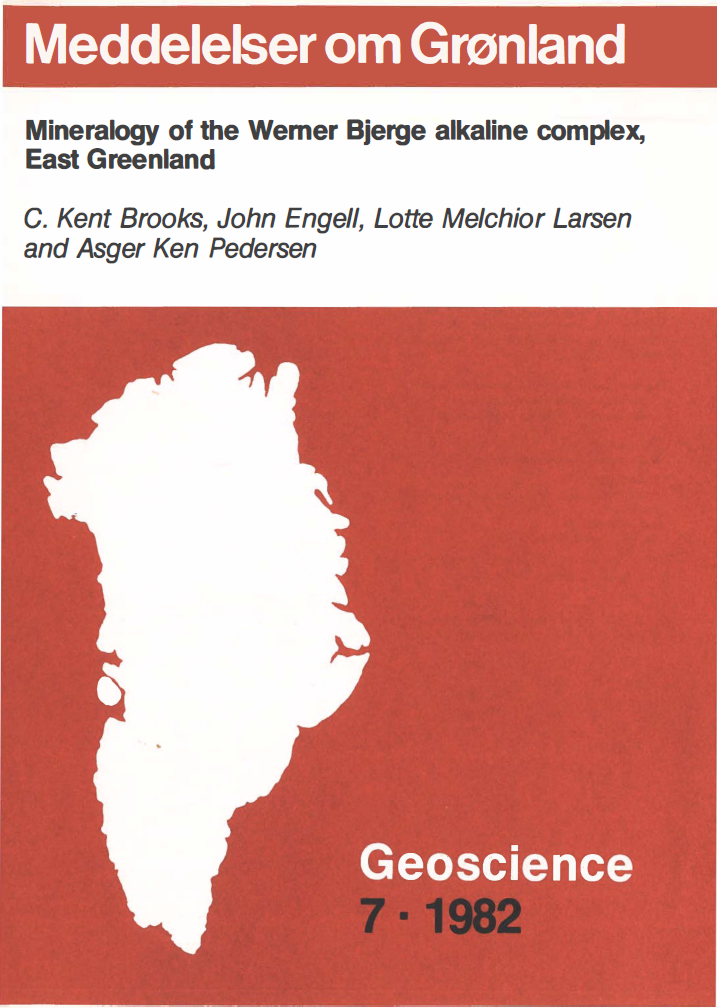Mineralogy of the Werner Bjerge alkaline complex, East Greenland
DOI:
https://doi.org/10.7146/moggeosci.v7i.138961Abstract
The Tertiary Werner Bjerge complex is divided into a basic complex, a northern complex and a nepheline syenite complex. The basic complex consists of cumulate rocks (ranging from ultramafic to gabbros) containing plagioclase, clinopyroxene, olivine and titanomagnetite with intercumulus kaersutite or biotite and subsolidus amphiboles and sheet silicates. Similar cumulates but containing cumulus kaersutite occur as inclusions in dykes associated with the nearby Theresabjerg intrusion and have been included in the study. The northern complex includes a wide range of felsic rock types of which two granites have been examined. In the nepheline syenite complex the rock types investigated include foyaites, a tinguaite, and quartz-bearing pegmatite. The main minerals in these rocks are alkali feldspar, nepheline, sodalite, alkali pyroxene, alkali amphibole and biotite together with a wide range of minor and accessory phases.
Clinopyroxenes vary from diopsides and salites in the basic rocks to aegirine-augites and acmites in the more evolved types, which are unusually MnO-rich. Titan-aegirines occur in the pegmatite.
The amphibole in the basic rocks is kaersutite; in the granite it is manganoan richterite, and in the nepheline syenite complex the amphiboles vary from hastingsitic hornblende through katophorite to manganoan arfvedsonite. The pegmatite contains unique Li-arfvedsonites. Minor late-stage calcic amphiboles occur in the basic rocks.
Sheet silicates include micas and secondary mixed layer types, chlorite and talc. Primary micas of the basic complex are titaniferous biotites and in the nepheline syenites are Mn-rich biotites, while the pegmatite contains the rare Li-mica, taeniolite.
Feldspars range from bytownite in the basic rocks to mainly alkali feldspar in the nepheline syenites which is often optically homogeneous and strongly potassic. Analyses of feldspathoids and zeolites are also presented.
The oxides of the evolved rocks are also MnO-rich and pyrophanite has been encountered in both the granite and the nepheline syenites. Other Mn-rich phases are also present, such as Mn-pectolite and kupletskite (the Mn analogue of astrophyllite). Data have also been acquired for a wide range of accessory phases including (additionally) sulphides (pyrrhotite, pyrite and sphalerite), apatite, sphene, titanian garnets, narsarsukite, pyrochlore, calcite, chevkinite and several unidentified zirconosilicates from the nepheline syenites.
It is concluded that the geochemical coherence between the various rock units of the intrusion suggests a comagmatic origin for these, while the close similarities between the mineralogies of the Kangerdlugssuaq and Werner Bjerge alkaline complexes suggest a similar origin.

Downloads
Published
How to Cite
Issue
Section
License
Coypyright by the authors and the Commision for Scientific Research in Greenland / Danish Polar Center. No parts of the publications may be reproduced in any form without the written permission by the copyright owners.

